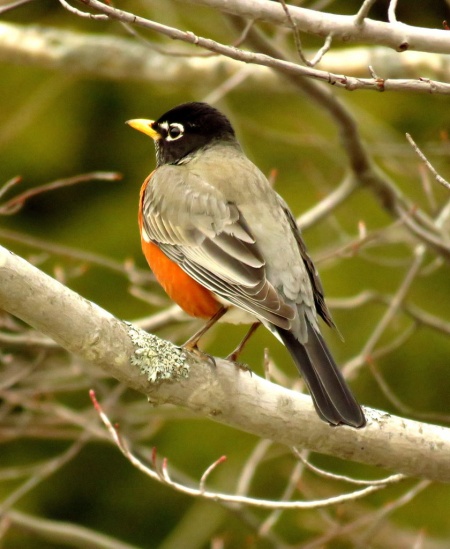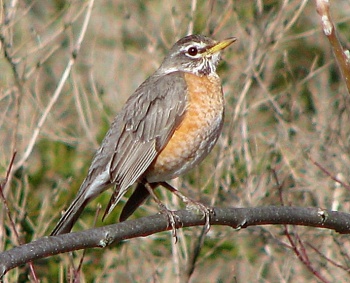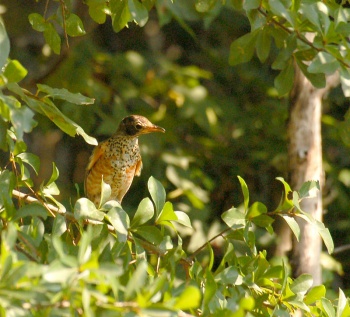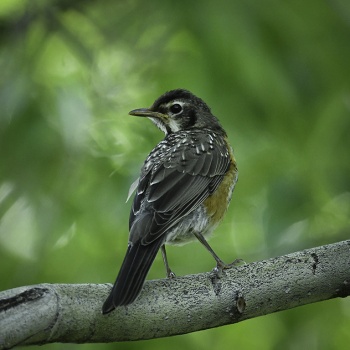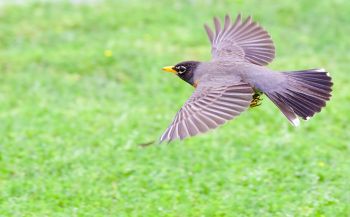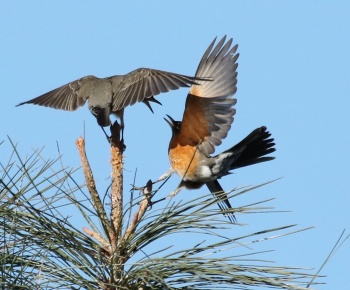- Turdus migratorius
Identification
Length 9-11 inches (23–28 cm); weight 2.7 oz
- Gray mantle.
- Head black in summer male, dark gray in female and winter male; with white streaks on throat.
- Brick-red breast in male, orange in female, with belly white and undertail coverts white with blackish streaks.
- White eye-crescents, interrupted at front and back.
- Bill yellow in males, dusky yellow in females; usually with a dark tip.
- Legs reddish-brown.
Juvenile: scaly dark brown spots on orangey breast; mantle with whitish spots or streaks.
Similar species
None in most of North America; in the mountains of Mexico Rufous-backed Thrush is similar, but readily distinguished by its back as well as breast being rufous-orange, and its lack of the white eye crescents.
Variations
The subspecies vary in intensity of color, with T. m. nigrideus the darkest and T. m. confinis the palest, and also slightly in size, with T. m. caurinus marginally the smallest.
Distribution
Most of North America.
Breeds over most of Canada, the United States, and Mexico; in the east as far as Labrador and Newfoundland, in the south to northern Florida, central Texas and southern California, with disjunct populations in the mountains of Mexico south to Chiapas; in the north absent from only the Arctic tundra in northernmost Canada and Alaska. Northern birds are migratory leaving breeding areas in September-October and eastern birds winter from Newfoundland southwards, returning late March-mid May.
Winters in southernmost Canada (southwest British Columbia and southernmost Ontario), throughout the United States except the nothern parts of the Great Plains states and northern New England, and throughout Mexico. The northern boundary of wintering is variable depending on the size of fruit crops, with birds remaining further north (even as far north as the Anchorage area of Alaska) in years with good berry crops.
Vagrant in the Western Palearctic, recorded in Iceland (four records) and the British Isles, France and Belgium, Germany, Denmark, Norway, Sweden, Czechoslovakia and Austria, also recently in Spain. Most frequently seen in Britain and Ireland (>30), mostly September-February with occasional records April-June. The records are scattered from Shetland to Scilly but there is a distinct bias towards the Northen Isles and the south-west.
Taxonomy
Subspecies
There are 7 subspecies[1]:
- T. m. nigrideus:
- Eastern Canada (Newfoundland and Labrador); winters along Atlantic coast of US
- T. m. migratorius:
- T. m. achrusterus:
- T. m. caurinus:
- Southeastern Alaska and western Canada to northwestern Oregon; winters to California
- T. m. propinquus:
- Eastern British Columbia to southwestern US and south-western Mexico; winters to Guatemala
- T. m. phillipsi:
- Eastern Mexico (south-western Tamaulipas to Puebla, Guerrero and Oaxaca)
- T. m. confinis: Pale buffy-brown underparts.
- Mountains of southern Baja California (Sierra de la Laguna)
Habitat
Open woodland and clearings in forest, farmland with copses and hedgerows, often in lowlands and frequently near water. In many areas has become an urban bird breeding in town parks and gardens.
Behaviour
Diet
Consists of about 40 percent invertebrates, such as beetle grubs, caterpillars and grasshoppers, and 60 percent fruit and berries (both wild and cultivated). Frequently seen running across lawns, running and stopping with an stiff erect posture, then stopping to pick up prey, which it locates by sight, not hearing.
Breeding
The female builds the nest and lays three or four blue eggs in the lined cup. The female does most of the incubation and it takes around a month for the chicks to fledge. There is often a second brood, the male caring for the fledglings whilst the female incubates the new clutch.
Bird banders have found that only about 25% of young birds survive the first year.
References
- Clements, J. F., P. C. Rasmussen, T. S. Schulenberg, M. J. Iliff, T. A. Fredericks, J. A. Gerbracht, D. Lepage, A. Spencer, S. M. Billerman, B. L. Sullivan, M. Smith, and C. L. Wood. 2024. The eBird/Clements checklist of Birds of the World: v2024. Downloaded from https://www.birds.cornell.edu/clementschecklist/download/
- Nestwatch
- Robins - info and games
- American Robin, Kingbirds, Bluebirds and Chickadees of North America
- American Robin - AbsoluteAstronomy.com
- Vanderhoff, N., P. Pyle, M. A. Patten, R. Sallabanks, and F. C. James (2020). American Robin (Turdus migratorius), version 1.0. In Birds of the World (P. G. Rodewald, Editor). Cornell Lab of Ornithology, Ithaca, NY, USA. https://doi.org/10.2173/bow.amerob.01
- Cornell Lab of Ornithology. 2019. American_Robin in: All About Birds. Cornell Lab of Ornithology, Ithaca, New York. https://www.allaboutbirds.org/ Accessed on 14May 2020.
Recommended Citation
- BirdForum Opus contributors. (2025) American Robin. In: BirdForum, the forum for wild birds and birding. Retrieved 15 May 2025 from https://www.birdforum.net/opus/American_Robin
External Links
GSearch checked for 2020 platform.1




